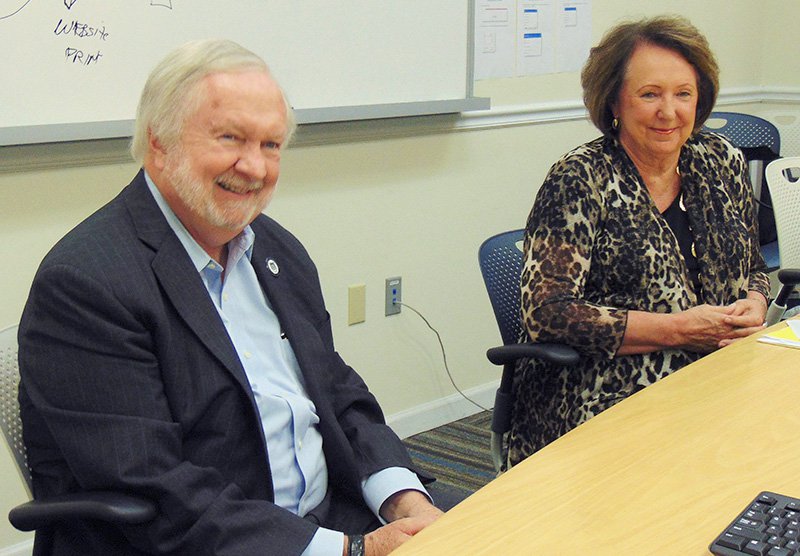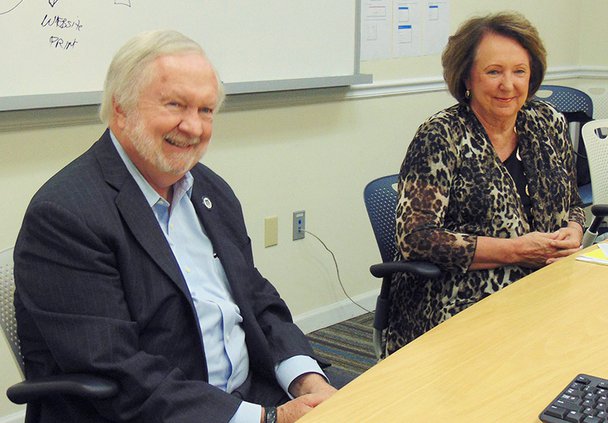Georgia ranks 39th among the 50 states in the number of physicians per capita, and about eight of Georgia's rural counties have no doctors at all, notes Brooks Keel, Ph.D., president of Augusta University, home of the Medical College of Georgia.
Keel, who was president of Georgia Southern University from January 2010 until July 2015, was back in Statesboro last week promoting MCG's plan to boost the number of doctors in rural Georgia. The program will shorten medical school by one year and make it tuition-free for up to 50 new doctors each year who fulfill a commitment to complete their residencies in Georgia and then serve at least six years in underserved, rural Georgia counties.
"It's a problem that we all have to come together to fix, but we just feel very strongly that as the state's medical school we need to take a leadership role on it," Keel said.
Besides being Georgia's only public medical school — the other four are part of private institutions — MCG is the largest medical school in the state. With 230 first-year medical students admitted each year, it is also the eighth largest in the country in first-year enrollment.
The plan, which Keel credits MCG Dean David Hess, MD, and the school's faculty for proposing, also calls for increasing the number of medical students in each class in Augusta by 50. With a separate move already funded to add 20 students over the next two years at MCG's "partnership campus" at the University of Georgia in Athens, MCG's annual first-year class would grow to 300 students.
Med school debt
With annual, in-state tuition and fees of $31,073, the Medical College of Georgia is also the least expensive medical school in the state for in-state students, and it is required to admit 95 percent of its students from within Georgia. But even at MCG, student loan debt averages $150,000 to $200,000 by the time a new physician graduates, Keel said.
Primary care doctors do not make as much money as specialists do, and their potential earnings are generally less in rural counties than in metropolitan areas, Keel said.
Meanwhile, Georgia becomes somewhat a victim of the success of its medical schools, to hear him tell it, as they turn out graduates who are accepted to residency programs operated by Johns Hopkins, Harvard, Duke and medical facilities across the country.
Only 20 to 30 percent of all the Georgia medical schools' graduating students typically stay in Georgia for their residencies, the post-graduate phase of their training where they gain specialized knowledge while treating patients.
"That's depending on the year, so let's say 25 percent. …," Keel said. "The other 75 percent leave the state, and that's true for all medical schools — us, Emory, Morehouse, Mercer — we're all in the same boat."
Staying in state
But tracking data on physicians' careers "shows that what motivates a medical student to stay in their community is where they do a residency program," he said.
This stands to reason, Keel notes, as doctors in residency get to know other physicians, establish relationships in a community, even get married and start families "and stay as opposed to coming back home."
When medical school students complete their residency in the same state where they finished medical school, data show that the number who remain in the state to practice medicine rises to about 70 percent, he said.
3+3+6 plan
To place primary care physicians in rural communities in Georgia and keep them there while eliminating much of their debt load, the Medical College of Georgia developed a multi-stage plan dubbed "3+3+6=0."
The first "3" stands for medical school shortened from the traditional four years to three years at MCG. The second "3" signals a student's commitment to do a three-year residency, the traditional length for primary care physicians, while remaining in Georgia. Then "6" represents the medical student and beginning physician making a commitment to practice six years after the residency in an underserved, rural part of Georgia.
With more obstetrician/gynecologists and general surgeons also needed in rural areas, the MCG faculty also proposed two variants of this formula: a 3+4+6 plan for OB/GYNS, whose residency lasts four years, and a 3+5+6 plan for general surgeons, with a five-year residency.
Incidentally, there is no lack of would-be medical students. MCG receives 13 applications for every seat. So the objective isn't to attract more applicants, but to accept 50 more students annually and steer that many toward underserved areas of rural Georgia.
Shorter med school
Reducing medical school from four years to three should in itself reduce the cost of medical school, and these students' resulting debt, by 25 percent, Keel noted.
Currently, about 12 medical schools, out of about 140 schools nationwide, offer a three-year program.
"So it's not unheard of," he said.
What is "almost unheard of," he added, is the free tuition part of the plan.
MCG must get permission for the condensed version of medical school from its accrediting organization, the Liaison Committee on Medical Education, and submitted the application this summer. The college proposes to reduce the required time in basic science courses and to require participants to attend classes during their first summer instead of having a break.
But students typically spend much of their fourth year applying and auditioning for residency programs. Some MCG students apply to 30 or 40 programs and interview for 12 or 15, requiring travel across the country, Keel said.
Sidestepping that search, the special program to produce rural doctors requires them to do their residency in Georgia. So the college will match each student with one of its existing residency programs.
"They will graduate from medical school without having to worry about trying to interview for a residency program, and the key is making sure we've got enough residency programs in the state for those students, too," Keel said.
Exactly what will happen if a doctor moves away from a qualifying area and fails to keep the six-year commitment is still being worked out. Another Augusta University staff member contacted last week said there will be an expectation for prorated repayment and that students will receive guidance about the expectations before committing to the program.
Cost to the state
Not fully funded yet, MCG's program carries an expected one-time start-up cost of about $15 million over five years, plus a continuing cost of $5 million a year for the forgiven tuition.
Augusta University officials met with Gov. Brian Kemp about the proposal in January before his inauguration. Keel said Kemp "got very, very excited about this" and "has already been tremendously supportive."
The university received $500,000 in the current year budget, which opened July 1, to "jump start," the planning, Keel said.
Another supporter in the state government is Rep. Jan Tankersley, R-Brooklet.
"You know, we have the Rural Development Council and we've been meeting all over the state, and this issue has risen to the top many times," Tankersley said. "And I hate to repeat (Keel's) words, but it's an innovative and bold plan, and it seems to be something that could actually work."
Keel and MCG officials hope to phase in the program beginning with new students in 2021.
Where is the need?
Georgia's 39th-place ranking is from the American Association of Medical Colleges' physician workforce profiles of the states.
"Southwest Georgia in particular is almost a third-world country in terms of the health disparities," Keel said.
Of the eight counties shown in the Georgia Board for Physician Workforce database as having zero physicians as of 2017, three — Quitman, Schley and Webster counties — are in the state's southwestern quadrant. But the other five doctor-less counties — Taliaferro, Glascock, Treutlen, Atkinson and Echols — form a dotted path southward through east-central Georgia from west of Augusta to the Florida line.
Far from doctor-less, Bulloch County had 114 physicians by the GBPW's count in 2017, among them 20 family medicine practitioners, 13 internal medicine practitioners and 10 pediatricians, the three primary-care categories. With more than 76,000 people, Bulloch would not qualify as rural for doctors' six-year commitment if MCG uses the GBPW's definition, which Keel said is likely. The board defines a rural county as one with fewer than 50,000 people.
However, neighboring counties such as Candler, Evans, Jenkins and Screven would qualify.
Coming Wednesday: What some rural hospital CEOs say about the program.
Herald reporter Al Hackle may be reached at (912) 489-9458.

